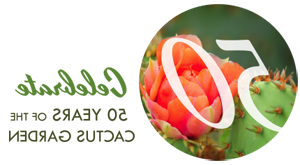仙人掌花园
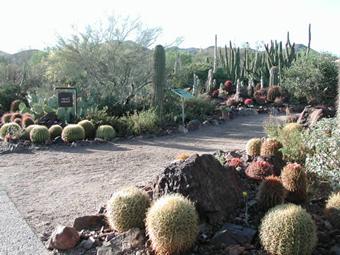
The 仙人掌花园 is a regional collection of cacti and succulents grouped by growth forms and specific genera. While walking through the garden you will be able to view dozens of species. Popular groups are Opuntias (prickly pears and chollas), Ferocactus(桶), 龙舌兰, 柱状仙人掌, Echinocereus(刺猬), and soon to include Mammillarias (pincushions).
仙人掌科(仙人掌科)
The enormous popularity of cacti among gardeners and plant collectors is surpassed only by that of roses and orchids. Their appeal extends far beyond their native habitat; there are legions of devotees in the eastern United States, 欧洲, 和日本. The desire to possess these strange yet beautiful plants supports hundreds of specialty nurseries; the largest shops grow and sell millions of plants annually. Cacti are one of the reasons tourists visit the American southwest.
Most people think they know a cactus when they see one, but they are often mistaken. All cacti are succulents, but not all succulents are cacti. 龙舌兰, 马鞭, 沉香, and the succulent euphorbias (such as African milk trees) are among the swollen or spiny plants often mistaken for cacti. 然而, the term cactus refers to a particular family of plants defined by a distinctive flower pattern. 成为仙人掌, the plant must produce flowers with the following characteristics: many tepals (combined sepals and petals) that intergrade with each other; many stamens (usually hundreds), and numerous stigma lobes (rarely only three). If a plant lacks such a flower, it cannot be a cactus.
The majority of cactus species are pollinated by numerous species of bees, 其中一些专门研究仙人掌. 仙人掌蜂都是独居的, but in some species the females congregate by hundreds of thousands at nesting sites to dig their individual nest burrows, which are densely concentrated in an area of a few thousand square feet. Cactus pollen is packed into these burrows to feed the grubs, which the parents do not tend. Some cacti are pollinated by birds, moths, or bats.
风琴管仙人掌
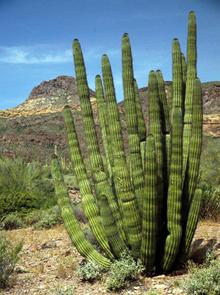
许多, usually unbranched stems that arise from ground level readily distinguish an organ pipe cactus from a saguaro. The stems also are thinner, and have solid woody cores. 植物通常长9到11英尺(2英尺).7-3.4 m) in height, but occasionally exceed 20 feet (6.1 m). 粉白色的花, 从4月到8月生产, open after dark and close shortly after sunrise. The spines on the fruit loosen and fall at ripeness. The juicy, sweet, red pulp contains many tiny seeds.
This tropical cactus is more frost sensitive than the saguaro, so it is restricted to the warmest microhabitats at its northern limit in the United States. It is most often found on south-facing rocky slopes below 3300 feet (1000 m) in elevation.
Nectar-feeding bats are the primary pollinators and some of the major seed dispersers. 因为花儿在黎明时分凋谢, diurnal animals are not significant pollinators as they are of saguaros. The fruits of organ pipe cactus are widely regarded as the second-best-tasting fruit of all cacti (after those of Stenocereus gummosus). Commercial harvest is feasible in some large populations, and fruits are sold in markets in Sonora and Baja California.
Senita

Senita generally grows 10 to 13 feet (3 to 4 m) tall and has the same general form as organ pipe cactus. It differs in having stems with only 5 to 7 (rarely up to 10) ribs and very short spines on the juvenile stems, 赋予它们锐利的棱角. Mature (flower-producing) stems are quite different; they're densely covered with long, 易怒的, 灰色的刺. Pink, nocturnal flowers about an inch (2.5 cm) in diameter emerge through the bristles from April through August; they emit an unpleasant odor. They are followed by marble-sized red fruits with juicy red pulp.
Senita has a recently discovered mutualistic relationship with a moth that deliberately pollinates the flowers and uses the developing fruit as food for its larvae. The relationship is very similar to that of the yucca and its pollinating moth, and only the third such example of a tight pollination-related mutualism known in the world. Senitas的寿命很长. When sites in Baja California photographed in 1905 were revisited in the 1990s, 几乎所有的参议员都还在.
鱼钩桶
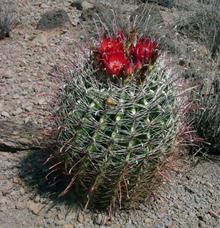
The thick, barrel-shaped body of this cactus is usually 2 to 4 feet (0.6-1.2 m) tall, occasionally reaching over 10 feet (3 m). 肋骨承受宽, 平, strongly-hooked central spines as well as several 易怒的 radial spines, but not enough of these to obscure the stem. The flowers are not strongly crowded by the spines and open wide. Flower color is extremely variable; on most plants they are some shade of orange, often with a stripe of darker shade on each petal. About 10percent of the plants have yellow or red flowers. They are produced over a 2-month-long season, 八月和九月, much longer than the blooming period of other barrels.
仙人掌蜜蜂(仙人掌科.给花授粉. The fruit persists until it is removed by animals and may remain on the plant for more than a year. Birds, 松鼠, and large mammals such as 鹿 and 一种野猪) are the main consumers of the fruit. Plants grow fairly slowly, and large specimens are more than a century old. 在培养, with supplemental water and fertilizer, they reach flowering size of 10 inches (25 cm) diameter and the same in height in about 12 years.
恩格尔曼刺梨
恩格尔曼刺梨 is a shrubby cactus forming hemispherical mounds up to 5 feet (1.高5米,宽2到3倍. Pad size varies with individual plants; the largest are over a foot (30 cm) long. (these giants may be hybrids with other species.)刺也是可变的. The O'odham recognize this variability in applying 4 or 5 names to different forms. 这些花是黄色的, 直径约3英寸(8厘米), and bloom in May near the end of the spring flowering season. They last a day each, and those of some plants age to orange by afternoon. The juicy fruit ripens to varying shades (from plant to plant) of rich purple to red. The specific status of this plant is still in dispute; it has been shuttled between Opuntia phaeacantha, O. discata和O. engelmannii by different taxonomists during the past few decades.
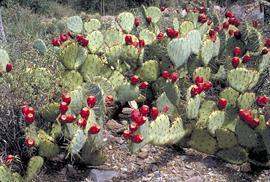
Engelmann and several other species of common, large prickly pears present an ecological mystery. The juicy, palatable fruits ripen in tremendous numbers in July and August. 大多数的瓜罗水果, produced in similar abundance earlier in the summer, 熟了就被吞吃吗. But 恩格尔曼刺梨 fruits persist for several months. Though they are eaten by a wide variety of animals including rabbits, packrat, 一种野猪), 鹿, 松鼠, 许多鸟类, 沙漠陆龟, 还有仙人掌甲虫, there are far too many fruits for them to consume. 此外, the fruits in the centers of large plants are out of reach of several of the wildlife species that would eat them; many of these fruits are still present in November fermenting and shriveling. Why would a plant seemingly waste energy in such overproduction? Could there be a vacant niche, a missing seed-disperser? The large, very hard seeds offer another possible clue. It has been suggested that some prickly pears coevolved with the now-extinct giant mammals, 比如猛犸象和地懒. 这是一个有趣的理论, 如果证明是真的, further illust利率 the already-established fact that natural systems are anything but static.
海狸尾巴仙人掌
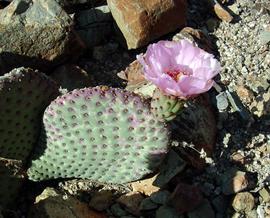
New pads of this species grow mostly from bases of older ones, resulting in sprawling plants seldom more than 2 pads tall. 块茎可长到6英尺(1英尺).直径8米). 脚垫是没有骨刺的, but have many hair-like glochids that make the areoles look like dots of felt. The incandescent-pink flowers appear from late February at the lowest elevations to May at the highest. The dry fruits contain very large seeds, even for an opuntia.
Nearly everyone who has had a close encounter with this or other ãspinelessä opuntias would rather have dealt with spines. Glochids通常太小而看不见, and they cause prickling pain and intense itching as the barbs work deeper into the skin with every movement. Removing hundreds or thousands of them after falling into such a plant is an exhausting and tormenting task. Some people shave them off at skin level, 这在一定程度上减少了刺激, even though this leaves the tips beneath the skin. A better remedy is to gently draw very sticky tape across the afflicted skin. Another effective treatment is to cover the area with a layer of white glue, 晾干后把它剥下来.
泰迪熊cholla
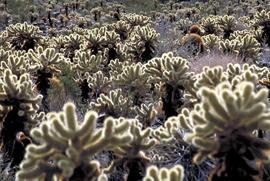
This distinctive cholla has a vertical trunk 3 to 5 feet (1-1.5 m) tall with densely-packed horizontal side branches on the upper foot (30 cm) or so. Older, lower side branches die and fall off. The joints are very densely spined; very little of the living surface can be seen through its armor. The spines are especially sharp and strongly-barbed. Young spines are yellow and become black with age. Yellow-green flowers in spring are followed by spineless fruits that usually contain no fertile seeds.
The detached joints will readily generate new plants by rooting and branching. During the cooler months the terminal joints are detached by a slight touch by a passing animal, 甚至是强风. The joints that attach to animals may be transported considerable distances before being dislodged. Since the fruits rarely contain viable seeds, this species reproduces almost entirely by this asexual process. Many plants have 3 sets of chromosomes instead of the ordinary 2; these are usually sterile. In some localities they form nearly impenetrable stands that occupy as much as 2 square miles of land almost to the exclusion of other plants. These giant, hillside-engulfing cholla forests may be a single (clonal) plant.








